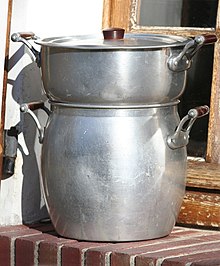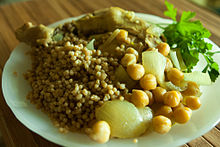Couscous, the Berber dish beloved across northern Africa’s Maghreb region and beyond, Wednesday joined the UN list of the world’s intangible cultural heritage. The countries that submitted the listing to UNESCO — Algeria, Morocco, Tunisia and Mauritania — may have their differences, but their common love of the grain staple runs deep. “Couscous, present at every social or cultural event, is at once ordinary and special,” their joint presentation argued. “Ordinary because of the frequency of its use in a family setting, and special because of the unifying and propitiatory role it plays at convivial community occasions at which food is shared.”
Bland by itself, couscous is served with meat or fish, spicey stews, chickpeas and vegetables in a mouth-watering variety of dishes. Moroccan restaurant owner Hicham Hazzoum was among the couscous connoisseurs who applauded UNESCO’s honour. “I think we are the only Arab countries to have a high regard for this dish,” he said. “It is impossible not to eat it every Friday. “Moroccans are crazy about couscous and even children love it. It shows that the couscous flame will never go out.” Across the region, couscous — also known as Seksu, Kusksi and Kseksu — is as elementary as rice or noodles are to Asian cuisine, the staple without which no meal is complete.
Arabic dictionaries have documented “Kuskusi” since the 19th century, though it is known to be far older. The regional pride in couscous found full expression in the countries’ joint nomination for the “knowledge, know-how and practices pertaining to the production and consumption of couscous”. “Women and men, young and old, sedentary and nomadic, from rural or urban communities or from immigrant backgrounds all identify with this element,” it gushed. “The ethos of couscous is the expression of community life.”
‘Great unifier’
Tunisian chef Taieb Bouhadra said his country took pride in its different types of couscous. “There are many varieties, almost every house has its own grain,” said the owner of El Ali restaurant, in the old city of Tunis. Couscous is prepared from wheat or barley, and sometimes from maize, millet or sorghum, which is ground into semolina. This is rolled into pellets which are sieved and later soaked and repeatedly steamed. “Women, in particular, play a fundamental role in the preparation and consumption of the dish, and in practising and preserving the related symbolic value systems,” said the paper. The girls learn not only the techniques, but also “the songs, gestures, characteristic oral expressions and ritual organisation” that go along with the process.
Algerian chef Rabah Ourrad said about making his couscous dishes: “I didn’t learn this in a cooking school. It’s decades of observing the mother, the sisters and all North African women who are experts in this.” In an often fractious region, there were hopes the joint bid would strengthen a sense of common identity. After Algeria four years ago sparked the ire of regional rival Morocco by planning its own couscous nomination, the 2020 bid was a cross-Maghreb initiative. Ourrad also passionately argued that couscous could serve as the region’s great unifier. Algeria, Morocco and Tunisia all have their particular styles, he said, but adding: “We are all the same people, and the couscous is Maghrebi, the couscous is ours.” Not everyone was fully on board with the mushy couscous diplomacy, including Hazzoum, the Moroccan restaurant manager. “I say this with all due respect to other countries,” he told AFP, “but Moroccan couscous is the best.”
AFP
The Couscous Wiki
Couscous
Couscous (Arabic: كُسْكُس, romanized: kuskus) is a traditional North African dish[5][6] of small[a] steamed granules of rolled semolina[7] that is often served with a stew spooned on top. Pearl millet, sorghum, bulgur, and other cereals are sometimes cooked in a similar way in other regions, and the resulting dishes are also sometimes called couscous.[8][9]: 18 [10]
Couscous is a staple food throughout the Maghrebi cuisines of Algeria, Tunisia, Mauritania, Morocco, and Libya.[11][12]: 250 It was integrated into French and European cuisine at the beginning of the twentieth century,[13] through the French colonial empire and the Pieds-Noirs of Algeria.[14][15][16]
In 2020, couscous was added to UNESCO's Intangible Cultural Heritage list.[17]
Etymology
The word "couscous" (alternately cuscus or kuskus) was first noted in early 17th century French, from Arabic kuskus, from kaskasa 'to pound', and is probably of Berber origin.[18][19][20] The term seksu is attested in various Berber dialects such as Kabyle and Rifain, while Saharan Berber dialects such as Touareg and Ghadames have a slightly different form, keskesu. This widespread geographical dispersion of the term strongly suggests its local Berber origin, lending further support to its likely Berber roots as Algerian linguist Salem Chaker suggests.[18]
The Berber root *KS means "well formed, well rolled, rounded."[18][19] Numerous names and pronunciations for couscous exist around the world.[21]: 919
History

It is unclear when couscous originated. Food historian Lucie Bolens believes couscous originated millennia ago, during the reign of Masinissa in the ancient kingdom of Numidia in present-day Algeria.[3][22][23][24] Traces of cooking vessels akin to couscoussiers have been found in graves from the 3rd century BC, from the time of the berber kings of Numidia, in the city of Tiaret, Algeria.[25] Couscoussiers dating back to the 12th century were found in the ruins of Igiliz, located in the Sous valley of Morocco.[26]
According to food writer Charles Perry, couscous originated among the Berbers of Algeria and Morocco between the end of the 11th-century Zirid dynasty, modern-day Algeria, and the rise of the 13th-century Almohad Caliphate.[20] The historian Hady Idris noted that couscous is attested to during the Hafsid dynasty, but not the Zirid dynasty.[20]
In the 12th century, Maghrebi cooks were preparing dishes of non-mushy grains by stirring flour with water to create light, round balls of couscous dough that could be steamed.[27]
The historian Maxime Rodinson found three recipes for couscous from the 13th century Arabic cookbook Kitab al-Wusla ila al-Habib, written by an Ayyubid author,[20] and the anonymous Arabic cooking book Kitab al tabikh and Ibn Razin al-Tujibi's Fadalat al-khiwan also contain recipes.[24]
Couscous is believed to have been spread among the inhabitants of the Iberian Peninsula by the Berber dynasties of the 13th century, though it is no longer found in traditional Spanish or Portuguese cuisine. In modern day Trapani, Sicily, the dish is still made to the medieval recipe of Andalusian author Ibn Razin al-Tujibi. Ligurian families that moved from Tabarka to Sardinia brought the dish with them to Carloforte in the 18th century.[28]
Known in France since the 16th century, it was brought into French cuisine at the beginning of the 20th century via the French colonial empire and the Pieds-Noirs.
Preparation

Couscous is traditionally made from semolina, the hardest part of the grain of durum wheat (the hardest of all forms of wheat), which resists the grinding of the millstone. The semolina is sprinkled with water and rolled with the hands to form small pellets, sprinkled with dry flour to keep them separate, and then sieved. Any pellets that are too small to be finished, granules of couscous fall through the sieve and are again rolled and sprinkled with dry semolina and rolled into pellets. This labor-intensive process continues until all the semolina has been formed into tiny couscous granules. In the traditional method of preparing couscous, groups of people come together to make large batches over several days, which are then dried in the sun and used for several months. Handmade couscous may need to be rehydrated as it is prepared; this is achieved by a process of moistening and steaming over stew until the couscous reaches the desired light and fluffy consistency.[29]
In some regions, couscous is made from farina or coarsely ground barley or pearl millet.

In modern times, couscous production is largely mechanized, and the product is sold worldwide. This couscous can be sauteed before it is cooked in water or another liquid.[29] Properly cooked couscous is light and fluffy, not gummy or gritty.
Traditionally, North Africans use a food steamer (called a taseksut in the Berber language, a كِسْكَاس kiskas in Arabic or a couscoussier in French language). The base is a tall metal pot shaped like an oil jar, where the meat and vegetables are cooked as a stew. On top of the base, a steamer sits where the couscous is cooked, absorbing the flavours from the stew. The steamer's lid has holes around its edge so steam can escape. It is also possible to use a pot with a steamer insert. If the holes are too big, the steamer can be lined with damp cheesecloth.
The couscous that is sold in most Western grocery stores is usually pre-steamed and dried. It is typically prepared by adding 1.5 measures of boiling water or stock to each measure of couscous and then leaving it covered tightly for about five minutes. Pre-steamed couscous takes less time to prepare than regular couscous, most dried pasta, or dried grains (such as rice). Packaged sets of quick-preparation couscous and canned vegetables, and generally meat, are routinely sold in European grocery stores and supermarkets. Couscous is widely consumed in France, where it was introduced by Maghreb immigrants[30] and voted the third most popular dish in a 2011 survey.[31][32]
Recognition
In December 2020, Algeria, Mauritania, Morocco, and Tunisia obtained official recognition for the knowledge, know-how, and practices pertaining to the production and consumption of couscous on the Representative List of the Intangible Cultural Heritage of Humanity by UNESCO. The joint submission by the four countries was hailed as an "example of international cooperation."[33][34]
Local variations

Couscous proper is about 2 mm in diameter, but there also exists a larger variety (3 mm more) known as berkoukes, as well as an ultra-fine version (around 1 mm).[20] In Morocco, Algeria, Tunisia, and Libya, it is generally served with vegetables (carrots, potatoes, and turnips) cooked in a spicy or mild broth or stew, usually with some meat (generally, chicken, lamb, or mutton).

Algeria

Algerian couscous is a traditional staple food in Algeria, and it plays an important role in Algerian culture and cuisine. It is commonly served with vegetables, meat, or fish. In Algeria, there are various types of couscous dishes.[20]
Tunisia

In Tunisia, couscous is usually spicy, made with harissa sauce, and served commonly with vegetables and meat, including lamb, fish, seafood, beef, and sometimes (in southern regions) camel. Fish couscous is a Tunisian specialty and can also be made with octopus, squid or other seafood in a hot, red, spicy sauce. Couscous can also be served as a dessert. It is then called Masfuf. Masfuf can also contain raisins, grapes, or pomegranate seeds.
Libya
In Libya, couscous is mostly served with lamb (but sometimes camel meat or, rarely, beef) in Tripoli and the western parts of Libya, but not during official ceremonies or weddings. Another way to eat couscous is as a dessert; it is prepared with dates, sesame, and pure honey and is locally referred to as maghrood.
Malta
In Malta, small round pasta slightly larger than typical couscous is known as kusksu. It is commonly used in a dish of the same name, which includes broad beans (known in Maltese as ful) and ġbejniet, a local type of cheese.[35]
Mauritania
In Mauritania, the couscous uses large wheat grains (mabroum) and is darker than the yellow couscous of Morocco. It is cooked with lamb, beef, or camel meat together with vegetables, primarily onion, tomato, and carrots, then mixed with a sauce and served with ghee, locally known as dhen.
Similar foods
Couscous is made from crushed wheat flour rolled into its constituent granules or pearls, making it distinct from pasta, even pasta such as orzo and risoni of similar size, which is made from ground wheat and either molded or extruded. Couscous and pasta have similar nutritional value, although pasta is usually more refined.[7]
Several dishes worldwide are also made from granules, like those of couscous rolled from flour from grains or other milled or grated starchy crops.
- Attiéké, a staple food in Côte d'Ivoire and surrounding regions of West Africa, is made from granulated grated cassava.
- Cuscuz (Portuguese pronunciation: [kusˈkus]) is a couscous-like dish from the Northeast Region of Brazil. It is made out of cornmeal and eaten hot with meat and cold with milk.[36] In the state of São Paulo the cuscuz is pressed into a mold decorated with orange slices, in a dish called "cuscuz Paulista," a variation of the original version made by locals after migrant waves from the Northeast Region.
- Dambou is a couscous-like dish from Niger. It may be made from semolina for special occasions but is often made with rice, millet, or other grain. Moringa leaves are traditionally included in the dish.[37][38] In France, this Nigerien dish has been adapted as a specific variant (called couscous aux épinards) of the Maghreb-syle couscous commonly found there, often using spinach in place of the moringa.[39]
- Fregula is a type of pasta from Sardinia. It is similar to North African Berkoukes and Middle Eastern Moghrabieh. Fregula comes in varying sizes but typically consists of semolina dough rolled into balls 2–3 mm in diameter and toasted in an oven.
- Kouskousaki (Κουσκουσάκι (in Greek) or kuskus (in Turkish) is a pasta from Greece and Turkey, that is boiled and served with cheese and walnuts.[40]

- In the Levant, the dish known as moghrabieh (a reference to the Maghreb region) uses the same durum-based semolina flour but rolled into larger (5–6 millimetres (0.20–0.24 in) in diameter) 'pearls' to create a dish that is popular across Jordan, Lebanon and Syria.[41] The pearls are either cooked as part of a stew or flavored with cinnamon and served alongside a chicken and chickpea broth.
- Palestinian maftoul uses granules that are larger than the North African variety but smaller than moghrabieh pearls (2–3 millimetres (0.079–0.118 in) in diameter) and made with bulgur, not durum wheat.[42] It is similarly served alongside a chicken and chickpea broth. "Maftoul" is an Arabic word derived from the root "fa-ta-la," which means to roll or to twist, describing the hand-rolling method used to make the granules.[29]
- Israeli couscous, known in Hebrew as ptitim (Hebrew: פְּתִיתִים, p'titím, lit. 'flakes', singular: פְּתִית, p'tít, lit. 'flake'), is made up of tiny balls of toasted pasta. It was developed in Israel in the 1950s when rice was scarce due to austerity in Israel as a higher protein alternative. Despite its name in English, it is not a type of couscous (Hebrew: כּוּסְכּוּס, kus'kus, plural: כַּסְכּוּסִים, kuskusím).
- Wusu-Wusu is a couscous that is prepared out of fonio in the Hausa region of Nigeria, Benin, Togo and Ghana.[43]
See also
- North African cuisine: Moroccan cuisine, Berber cuisine, Algerian cuisine, Tunisian cuisine, Libyan cuisine and Egyptian cuisine
- List of Middle Eastern dishes
- List of African dishes
Notes
- ^ Usually about 2 millimetres (0.079 in) in diameter, though a finer (1 mm) and larger varieties (3 mm or more) also exist in North Africa.
References
- ^ Chemache, Loucif, Farida Kehal, Hacène Namoune, Makhlouf Chaalal, and Mohammed Gagaoua. "Couscous: Ethnic making and consumption patterns in the Northeast of Algeria." Journal of Ethnic Foods 5, no. 3 (2018): 211-219. “Couscous or seksu (Image 1) in Berber language or kuskus in Arabic is by origin a Numidian (the Berber population of Numidia) dish…”
- ^ Hammami, Rifka, Reine Barbar, Marie Laurent, and Bernard Cuq. "Durum Wheat Couscous Grains: An Ethnic Mediterranean Food at the Interface of Traditional Domestic Preparation and Industrial Manufacturing." Foods 11, no. 7 (2022): 902. pp.1-2. “Part of the origin of couscous is related to Numidians, the Berber population of Numidia. The culinary historian Lucie Bolens describes primitive pots that closely resemble the main cooking utensil of couscous, which is the couscoussier, found in Kabylia in tombs coming from the period of Berber king Massinissa”
- ^ a b Bolens, Lucie (1990). La cuisine andalouse, un art de vivre: XIe-XIIIe siècle. Albin Michel. ISBN 9782226041005. Retrieved May 19, 2022.
- ^ "Health Benefits of Couscous". WebMD.
- ^ "Couscous". Encyclopedia Britannica. Retrieved May 19, 2022.
- ^ Chemache, Loucif; Kehal, Farida; Namoune, Hacène; Chaalal, Makhlouf; Gagaoua, Mohammed (September 2018). "Couscous: Ethnic making and consumption patterns in the Northeast of Algeria". Journal of Ethnic Foods. 5 (3): 211–219. doi:10.1016/j.jef.2018.08.002. ISSN 2352-6181. S2CID 133982691.
- ^ a b Shulman, Martha Rose (February 23, 2009). "Couscous: Just Don't Call It Pasta". The New York Times. Retrieved May 19, 2022.
- ^ Taylor, J.R.N.; Barrion, S.C.; Rooney, L.W. (2010). "Pearl Millet—New Developments in an Ancient Food Grain" (PDF). Cereal Foods World. 55 (1). Cereal and Grains Association: 16–19. doi:10.1094/CFW-55-1-0016. Retrieved May 19, 2022.[dead link]
- ^ Taylor, J.R.N.; Barrion, S.C.; Rooney, L.W. (2010). "Pearl Millet—New Developments in an Ancient Food Grain" (PDF). Cereal Foods World. 55 (1): 16–19. doi:10.1094/CFW-55-1-0016. Archived from the original (PDF) on August 22, 2019. Retrieved May 19, 2022.
- ^ "The Codex Alimentarius (Codex Standard) (1995)" (PDF). Food and Agriculture Organization of the United Nations. Retrieved May 19, 2022.
- ^ Naylor, Phillip C. (May 2015). Historical Dictionary of Algeria. Rowman & Littlefield. p. 195. ISBN 978-0-8108-7919-5.
- ^ Soletti, Francesco; Selmi, Luca (2006). Turismo gastronomico in Italia, Volume 1. Touring Club Italiano. ISBN 978-88-365-3500-2.
- ^ Sainéan, L. (1921). "L'HISTOIRE NATURELLE DANS L'OEUVRE DE RABELAIS (8 e et dernier article)". Revue du Seizième siècle. 8 (1/2): 1–41. ISSN 0151-1823. JSTOR 41851648.
- ^ Wagda, Marin (1997). "L'histoire d'une migration culinaire". Hommes & Migrations. 1207 (1): 163–166. doi:10.3406/homig.1997.2982.
- ^ Tabois, Stéphanie (2005). "Cuisiner le passé. Souvenirs et pratiques culinaires des exilés pieds-noirs". Diasporas. Histoire et sociétés. 7 (1): 81–91.
- ^ Albert-Llorca, Marlène (2004). "La mémoire des Pieds-noirs : une transmission impossible ?". Horizons Maghrébins - le droit à la mémoire. 51 (1): 169–176. doi:10.3406/horma.2004.2250.
- ^ "UNESCO adds couscous to list of intangible world heritage". Al Jazeera English. December 16, 2020. Retrieved May 19, 2022.
- ^ a b c Chaker, Salem. "Couscous : sur l'étymologie du mot" (PDF). INALCO - Centre de Recherche Berbère. Archived (PDF) from the original on August 16, 2011.
- ^ a b Chastanet, Monique; Franconie, Hélène; Sigaut, François (March 2010). Couscous, boulgour et polenta. Transformer et consommer les céréales dans le monde (in French). Karthala Editions. ISBN 978-2-8111-3206-4. Retrieved May 19, 2022.
- ^ a b c d e f Perry, Charles (1990). "Couscous and Its Cousins". In Walker, Harlan (ed.). Oxford Symposium on Food & Cookery, 1989: Staplefoods : Proceedings. Oxford Symposium. pp. 176–178. ISBN 978-0-907325-44-4. Retrieved May 19, 2022.
- ^ Foucauld, Charles de (1950–1952). Dictionnaire touareg-français : dialecte de l'Ahaggar (in French). Paris: Impr. nationale de France. Retrieved May 19, 2022.
- ^ "Can North Africa unite over couscous?". AFP. February 2, 2018.
- ^ "The unexpected allure of couscous: the history and tradition behind the North African staple". The National News. December 20, 2020.
- ^ a b de Castro, Teresa (2003). "COUSCOUS". In Katz, Solomon H.; Weaver, William (eds.). Encyclopedia of Food and Culture. Vol. 3. Charles Scribner's Sons. p. 466. ISBN 0-684-80565-0.
- ^ "Can North Africa unite over couscous?". France 24. February 13, 2018. Retrieved May 19, 2022.
- ^ Fili, Abdallah; Ettahiri, Ahmed Saleh; Van Staëvel, Jean-Pierre; Serrat, Ihssane (2020). "Première approche typologique de la céramique protoalmohade d'Igiliz (Maroc)" [First typological approach to the proto-Almohad pottery of Igiliz (Morocco)]. Bulletin d'Archéologie Marocaine. 25 (25): 101–123. doi:10.34874/IMIST.PRSM/bam-v25.29693. eISSN 2820-6908. ISSN 0068-4015.
- ^ Zaouali, Lilia (September 2009). Medieval Cuisine of the Islamic World: A Concise History with 174 Recipes. Univ of California Press. p. xiii. ISBN 978-0-520-26174-7. Retrieved May 19, 2022.
- ^ Zaouali, Lilia (September 2009). Medieval Cuisine of the Islamic World: A Concise History with 174 Recipes. Univ of California Press. pp. 45–46. ISBN 978-0-520-26174-7.
- ^ a b c Asbell, Robin (August 2007). The New Whole Grain Cookbook: Terrific Recipes Using Farro, Quinoa, Brown Rice, Barley, and Many Other Delicious and Nutritious Grains. Chronicle Books. ISBN 978-1-4521-0042-5.
- ^ Randall, Colin (March 31, 2006). "French abandon traditional cuisine in favour of couscous". The Daily Telegraph. Retrieved May 19, 2022.
- ^ "Les plats préférés des Français". Archived from the original on April 8, 2012. Retrieved May 19, 2022., enquête réalisée en août 2011 pour le magazine Vie Pratique Gourmand auprès d'un échantillon national de 999 personnes représentatif de l'ensemble de la population âgée de 18 ans et plus, interrogées en face à face. Méthode des quotas (sexe, âge, profession du chef de ménage PCS) et stratification par région et catégorie d’agglomération.
- ^ "Magret is the No1 dish for French - Moules-frites and couscous trail duck dish as study looks at what's on people's plates". The Connexion - French News in English. November 30, 2016. Retrieved May 19, 2022.
- ^ "UNESCO - Knowledge, know-how and practices pertaining to the production and consumption of couscous". UNESCO. December 1, 2020. Retrieved May 19, 2022.
- ^ "Couscous joins UNESCO Intangible Cultural Heritage list". Deutsche Welle. December 17, 2020. Retrieved May 19, 2022.
- ^ "Kusksu - A traditional Maltese soup made with broad beans, peas and giant couscous". A Maltese Mouthful. January 5, 2016. Retrieved August 26, 2023.
- ^ "Receitas". revistagloborural.globo.com. Archived from the original on January 29, 2008. Retrieved August 9, 2017.
- ^ United Nations Development Programme - Climate Change Adaption Facility (June 2017). "CCAF Cookbook". Adaptive Farms, Resilient Tables: Building secure food systems and celebrating distinct culinary traditions in a world of climate uncertainty. p. 66. Retrieved May 19, 2022.
- ^ Collaborative Crop Research Program. "Nutrition for Agriculture: Food Processing 2009-2017" (PDF). The McKnight Foundation. Archived (PDF) from the original on October 24, 2020. Retrieved May 19, 2022.
- ^ "Couscous aux épinards - Dambou (Niger)". Recettes Vegetales. Retrieved May 19, 2022.
- ^ Hammami, Rifka; Sissons, Mike (2020). "Durum Wheat Products, Couscous". In Igrejas, Gilberto; Ikeda, Tatsuya M.; Guzmán, Carlos (eds.). Wheat Quality for Improving Processing and Human Health. Springer International Publishing. pp. 347–367. doi:10.1007/978-3-030-34163-3_15. ISBN 978-3-030-34163-3. S2CID 216234604. Retrieved May 19, 2022.
- ^ Hutcherson, Aaron (May 14, 2021). "A guide to couscous: The history, different types and how to cook with it". The Washington Post. Retrieved May 19, 2022.
- ^ Ottolenghi, Yotam (April 26, 2013). "Yotam Ottolenghi's maftoul recipes". The Guardian. Retrieved May 19, 2022.
- ^ Martin Brink, Getachew Melese Belay (2006). Céréales et légumes secs. PROTA. p. 60. ISBN 978-90-5782-172-1. Retrieved May 19, 2022.
UNESCO’s Inscription of Couscous Traditions, an Example of International Cultural Cooperation









